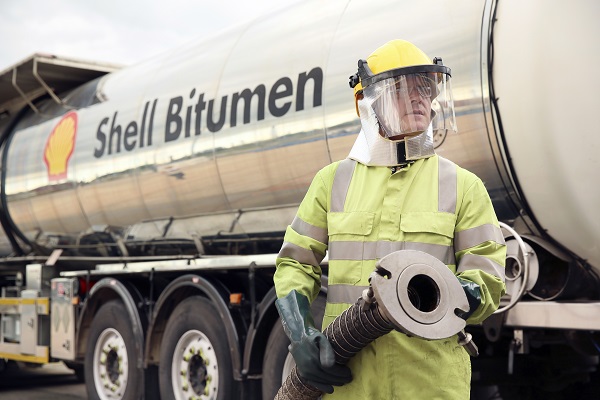
Professor John Read is general manager of Bitumen Technology at Shell Bitumen, leading a team of over 100 technical specialists in the delivery of new bitumen products. Here, he tells Guy Woodford about the pressing need for the bitumen sector to work ever more closely with its customers, including quarry operators, to ensure future success in a rapidly changing industry.
Professor John Read is well placed to appraise current and likely future trends within the global bitumen market, having spent 220 days of last year and a sizeable chunk of this year travelling on work-related business to all corners of the globe.
“I try to go in two-week batches. I have a lot of engagement with senior customers, governments and agencies. A lot of my role is around thought leadership for
“World bitumen demand is somewhere between 95 million and 110 million tonnes,” continues Read. “It’s a very large market and historically that market has been serviced by local oil companies with small refineries producing bitumen that travels about a 300 kilometre radius around each refinery. Any quarries near to that refinery would utilise that bitumen. If there were any problems with the bitumen, the quarry operator would use adhesion promoters and generally find ways to make it work. That is all fundamentally changing.”

Read says a lot of the traditional refineries of the past have closed or are slated to close as they are not economically viable. “You need to have very complex refineries that can make value added products, such as higher value fuels. You want complex conversion units so you can crack molecules to turn heavy residues into lighter fuels – whether that’s jet fuels, motor gasoline or diesel. As a society, we are demanding ever more of these fuels.”
The problem for the bitumen market in the creation of ever more complex refineries is that they tend not to produce bitumen, notes Read. “There has been a real concern for quite some time that the world is going to go short,” he continues. “This has led to a number of traders, including ourselves, who have really moved into the logistics of moving big bulk bitumen over long distances. There are more bitumen ships being built than ever before. Those ships are getting ever bigger. They used to be 2-3,000 tonnes, maybe 4-5,000 tonnes for the biggest doing short cross-regional trips. Now we’re talking about ships carrying up to 45,000 tonnes, and they’re intercontinental. Production and demand centres are completely dislocated. You need to have the logistics to move bitumen to where people need it.”
Global demand for bitumen is growing, says Read, with bitumen growth broadly aligned with world GDP growth – as emerging market countries, in particular, look to grow their infrastructure. Read believes the Central Asian ‘Stan’ republics (Afghanistan, Tajikistan, Kyrgyzstan, Uzbekistan, Turkmenistan, Kazakhstan) and North, East and West African coastal countries are key growth markets for the bitumen sector going forward.
“These are regions that do not have a developed road network. To enable them to get to the same living standards we have today, we expect them to follow on in terms of massive investment in road networks from the BRIC [Brazil, Russia, India and China] countries. After the Stan countries, it will be Africa’s turn, specifically countries such as South Africa, Kenya, Egypt, Tunisia, Morocco, and Algeria – coastal locations exposed to the wider world. These will be followed by some internal African countries. A lot of World Bank money is going into Africa to help with road network development.”
Read says that in his role at Shell Bitumen, he has worked closely with the World Bank on sustainability projects in various countries.
“The World Bank used to say, and may still do, that it was better for them to invest a dollar in roads, than a dollar in irrigation. If you connect two villages, they begin to trade. That creates wealth, and that wealth is used to purchase goods. Then you create the next village road and trade link.
“I was visiting one road in the Ivory Coast funded by the World Bank. The way that they built the road was something to behold. It’s not like we’d do it here. There’s no asphalt plants or anything of that nature. There’s no quarries. Each man is given a 10 metre section of road they are going to build, and they go and break rocks by hand. They put them in a wheelbarrow and then get a drum of bitumen and put it on an open fire, which they know is hot enough when the lid blows. Then they tip a little bit of bitumen into the wheelbarrow, mix it with a big wooden spoon. They tip it onto the ground and make about one square metre. They tamp it by hand. Then they do another square metre, and so on until they’ve done their 10 square metres. Then another man comes and does his 10 metres. It means every man in the two villages being linked by this new road is employed and gets paid for this work.
“I said to the World Bank ‘We could do this much more effectively using Bitutainers’, much bigger and self-heated containers of bitumen. But their guy on the ground said ‘You don’t understand. The value of your drum of bitumen is not in the bitumen, it’s in the drum’. That’s because once the bitumen had been used to make a bit of road, the drum user will take it and use it as a container, completely lined and waterproofed with bitumen, to catch the rainwater from the roof of his home. Meanwhile, the drum lid is hammered into a pan, which is used along with the collected rainwater to cook. Eventually when the drum starts to leak, they split it and open it out, so that it becomes roofing material. It makes perfect sense when someone explains it to you!”

Accompanying specific world regional growth in bitumen demand will, says Read, be a greater demand for added value bitumen products. “There is now a realisation and acceptance that Polymer Modified Bitumens, for example, provide much better whole life costing and performance than conventional bitumens. Added value product penetration in road building globally has been around 10%, but we expect that to grow to around 25% in developed countries, with the developing countries following on behind.”
Another key impending change affecting the bitumen market will be when the International Maritime Organisation (IMO) specifies a reduction of sulphur in marine fuels – down from 2.5% to 0.5%. “Possibly, this means there will be a lot of high sulphur residue coming onto the market,” says Read. “You may argue ‘That’s good as it’s feed stock for bitumen’. The issue is that all bitumen can be put into a fuel oil pool, but not all fuel oils can make bitumen. There’s still a big question within the IMO on whether they will introduce this specification in 2020 or 2025. At Shell Bitumen, we are planning for this to be 2020. Building the type of kit you need to benefit from this takes five to ten years.”
On Shell Specialities’ R&D work, Read says he and his research team have identified 13 deficiencies seen commonly in bitumens. “This includes poor adhesion, poor cohesion, poor ductility, low viscosity, high viscosity, or unpleasant smell,” he explains. “Just because you’ve got a high viscosity residue, it does not make that a suitable bitumen.
“One of the big thrusts in our R&D is to address all of these 13 deficiencies at a molecular level. Historically we’ve addressed bitumen deficiencies by additivation of one form or another: if it didn’t adhere properly, we used an amine-based wetting agent, or if there was high viscosity, we would blend lower viscosity material into it.
Shell Bitumen’s strategy
“Shell has decided that we’re going to continue to produce bitumen. But we’ve decided that it’s not economical to do that in all locations. So we’ve centred on nine of the Group’s 42 refineries where we’ll produce bitumen. The ambition is for those to be a million tonnes plus per refinery. In Europe we’re well catered for. We’ve got a joint venture at Eastern Refinery Ltd in the UK; three in Germany – the Cologne Godorf refinery, PCK Schwedt refinery and the MiRO joint venture refinery, and the Pernis refinery in the Netherlands.”
The Pernis facility is the largest integrated refinery complex in Europe and occupies a strategic location in the Rotterdam industrial region. Shell continues to invest and increase its bitumen supply capabilities in the European market, especially in the Rotterdam area. “Based on these production points, we’ve set up logistics to move bitumen down the Rhine, to get out to Rotterdam, and then to ship anywhere,” explains Read.
Read says he is keen to deconstrain the refineries. “I don’t want to say to the refineries ‘You must run this crude or that crude’. Give or take there are 2,500 crudes around the world. Of those, only around 300 are suitable for producing the added value bitumen as we produce it today. I’d like to say to the refineries ‘Just produce a hard residue out of any crude’.” Read says that the produced hard residue will, at some point in the future, be able to be taken away and turned into specialist bitumen after its deficiencies are identified and addressed thanks to the work done by himself and his Shell Specialities R&D team at the molecular level.
Read says Shell Bitumen is working with IBM on atomic force microscopy using very specialist techniques, allowing him and his research team to see asphaltene structures at the molecular level. “All the predictions on what we thought they looked like can now be corroborated or not. Then based on all that information and other testing we can do, we can use our supercomputing to truly model the [molecular] structures,” explains Read. “If you take the asphaltene compounds and rotate it in three dimensions, you’ll see it’s a structure made up of parallel plates. Those parallel plates are all joined by carbonal chains. These chains control ductility – how stretchable or brittle your bitumen is. The more entanglement of the carbonal chains, the more brittle your bitumen is. If you can control and break the carbonal chains, and only leave enough attached so that you still have a structure, the plates can now slide over each other, allowing you to make a ductile bitumen from what was a brittle bitumen. It’s something we could never do before.”
Seven “maybe eight”, says Read, of the specified 13 deficiencies with bitumen make-up identified by Shell Bitumen’s general manager and his R&D team can now be rectified, thanks to Shell Bitumen molecular engineering. This has led to a range of new specialist bitumen products coming onto the market in the last 18 months. “One of the new products is Shell Bitufresh which removes smell from the bitumen, rather than simply masking it. This is done by chemically converting the mercaptans, the smell generating compounds within the bitumen, by attaching really heavy molecules from the Bitufresh to the mercaptans, making them incredibly heavy and dense, so that they sink to the bottom of the bitumen, preventing their release.
“By the end of 2018 or early 2019, I think we’ll have ten of the 13 bitumen make-up deficiencies cracked. What we’re looking to do is make all these [new bitumen make-up] technologies for post-processing residue available at depots, rather than at refineries. Doing anything at refineries is incredibly expensive, and it almost always creates bottlenecks.”
Advanced applications
Other key new Shell Bitumen products include LT Grades [Low Temperature], S-Grades [Enhanced Productivity], Cariphalte Race Track and Cariphalte Airfield [specialist bitumen for motorsport race tracks and airfields respectively]. “With the Cariphalte products, we are doing most of the Formula 1 tracks, many large-scale roofing and infrastructure projects, as well as paving many runways, including eight out of the ten busiest airports in the world,” says Read. “This is important for two reasons: one, it means we have high performance, added value products that set us apart from the competition. And two, because the technology we put into these products is the technology that we’ll see on infrastructure such as public roads in the coming years.”
Furthermore, Read is keen to explain why new specialist bitumen innovation through molecular engineering is so important in the modern world. “If you look at society as a whole, the road network is the single biggest asset that any society owns. The investment is in the high billions or trillions, depending on the countries concerned. You cannot afford to go back and rebuild your road network. So there’s a social angle that we have to engineer our bitumens and asphalts to be ever better and cope with the increasing number of trucks on our roads, and to deal with the fact that every change that any truck manufacturer seems to make is good for the trucks, their fuel economy, and for environmental sustainability, but very bad for the road.
“For example, we moved from having double wheels per axle to having super single tyres. The contact area you have on the road has got smaller, but you have the same weight, now over a smaller area. This means you are placing a higher stress on that road pavement area. Tyre pressures have also been increased, which reduces tyre wear but reduces the contact area on the road, making it bad for the road. Trucks have now got hydraulic suspensions which were great for driver comfort when they were first introduced, but over time they are not maintained, and the damage this causes to the road through dynamic steel on steel impact can be up to three times the static damage.

“As a consequence to all this, we are seeing more early life road failures across the world. We need solutions to all these things – including having higher quality bitumens. The initial cost in creating these solutions may be higher, but far less than the cost and disruption of having to do early road life rehabilitations.”
But Read also points to the importance of increased recycling of asphalt mixes and constructive evaluations of the suitability of alternative sources of recyclable material into asphalt mixes. “We aim to become the leading force in sustainable pavement products and solutions, delivering important social and environmental benefits to the world.” To that end, Shell recognises the value of Recycled Asphalt Planings (widely known as RAP) and Recycled Shingles as a valuable source of sustainable raw material for use in asphalt manufacture. In markets like Germany, Read says that many of the tenders are predicated on a high percentage of RAP and Shell works closely with asphalt companies to deliver solutions to contractors, highways agencies and government
Working with quarries
Returning to the subject of innovation, Read says that Shell Bitumen’s quarry-based customers can greatly benefit from Shell Bitumen’s bitumen molecular engineering research. “It means we can talk with any quarry customer, look at their aggregate and design a bitumen to work with it. If it typically has poor adhesion, we can improve this by changing the balance of resins to asphaltenes. If the quarry’s asphalt plant is close to an urban environment, we can use Bitufresh to remove any smell, so that the quarry is seen as a good neighbour.”
Last year, there was plenty of coverage given to the Dutch port city of Rotterdam’s proposed trialling of plastic paved roads. There has also been talk of in-built solar-panel road trials in other parts of the world. So is Read confident about bitumen’s long-term viability as a road surface? “Bitumen production globally leads to the creation of two billion tonnes of asphalt each year. You can’t replace two billion tonnes of asphalt with solar panels. There isn’t enough material and the cost would be tremendous. In another 50 years, we’ll still be using asphalt on roads. The base properties of it will have changed, but I think we’ll be laying it the same.
“I also see the quarrying sector being more important than it ever has for bitumen producers. Historically, the quarry produced the aggregate and bought bitumen. Because they were buying bitumen of good quality, produced through a standardised process from selective crude stocks, it always worked. Moving forward, due to the changes that I described earlier, that’s not necessarily going to be the case. The ability for a quarry customer to be able to tell us exactly what they need is going to be more and more important, as we’re going to be able to engineer a bitumen specifically for your quarry or group of quarries’ aggregates.”










